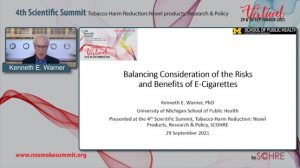Professor Kenneth Ε. Warner, a “guru” in the field of tobacco harm reduction and public policy―as chair Dr. Karl Erik Lund said―in his keynote lecture, talked about the need for balancing considerations of the risks and benefits of e-cigarettes, presenting the findings of a recent paper published in the American Journal of Public Health in August 2021.
The paper describes the situation in US, Professor Warner said, where governmental health agencies and non-governmental medical and health organisations focus heavily on risks to kids and not on the potential benefits for adult smokers.
There is growing strong evidence that vaping increases smoking cessation, Professor Warner said, evidence coming from RCTs, population studies, sales data on cigarettes and e-cigarettes (and HTPs); research demonstrating the unintended consequences of policies restricting vaping, and experience from the natural experiment in harm reduction (snus).
Four population studies in the US and UK found that vaping increased smoking cessation by 10-15%, the speaker explained, a finding that is consistent with a near doubling of quit attempt success found in RCTs. Population studies show also that regular and frequent e-cigarette use leads to increased smoking cessation, while infrequent use does not. Sales data show an inverse relationship between cigarette and e-cigarette sales, he added, and a number of economic studies show positive cross-price elasticity of demand between cigarettes and e-cigarettes that indicates that e-cigarettes are used as substitutes.
Professor Warner named the principal concerns about youth vaping, namely, that vaping can cause nicotine addiction, vaping by never-smoking youth can drive some of them to try smoking, and young people’s developing brains can be harmed by nicotine.
Although it is probable that some youth may become addicted to nicotine by vaping, the number is likely relatively small, Professor Warner said, while frequent vaping is much more common among current or former young smokers, who were already addicted to nicotine prior to initiating vaping, than among never-smokers. As for the second concern, he added, most of prospective studies have not controlled for logical covariates, while the concern about harming young people’s developing brain is based on animal studies and there is no evidence linking nicotine use by youth with later adverse outcomes. For a number of reasons, the speaker noted, it seems unlikely that, for youth as a whole, vaping creates dangerous levels of nicotine exposure that would not have occurred in the absence of vaping.
It is essential to balance concerns about risks to youth with potential benefits for adult smokers. Heavy emphasis in the US on adverse effects on youth, according to Professor Warner, likely reduces adult smoking cessation, since most adults erroneously believe that the vaping is at least as dangerous as smoking.
Some policies oriented toward one goal harm the other, therefore we need to seek policies that constructively address one goal with no more than minor adverse effects on the other, he added, and gave some examples of such policies.
We can increase smoking cessation through vaping, Professor Warner concluded. Vaping’s ability to promote smoking cessation is important and deserves more attention, since helping adult smokers to quit is a matter of social justice.


